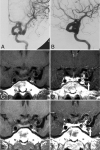Localized Marked Elongation of the Distal Internal Carotid Artery with or without PHACE Syndrome: Segmental Dolichoectasia of the Distal Internal Carotid Artery
- PMID: 29545249
- PMCID: PMC7410667
- DOI: 10.3174/ajnr.A5573
Localized Marked Elongation of the Distal Internal Carotid Artery with or without PHACE Syndrome: Segmental Dolichoectasia of the Distal Internal Carotid Artery
Abstract
Background and purpose: Segmental intracranial dolichoectasia of the distal ICA is a feature of PHACE syndrome or a sporadic phenomenon. We evaluated the relationship between intracranial dolichoectasia of the distal ICA and PHACE syndrome and illustrated the characteristic radiologic findings of the lesions.
Materials and methods: Intracranial dolichoectasia of the distal ICA was identified in 20 patients at our institution from 2005 to 2016 through a review of diagnostic cerebral angiography results. All radiologic images were reviewed to determine the vascular morphologic dispositions around the distal ICA, including dysplasia, mural calcification, vessel wall enhancement, lumen narrowing, and aneurysm formation. Medical records were reviewed to determine the symptoms of PHACE syndrome. Subsequently, the correlation between radiologic findings and PHACE syndrome was assessed.
Results: In this cohort, which had a strong female predominance (male/female ratio= 2:18), intracranial dolichoectasia had a more ipsilateral vascular morphologic disposition. Mural calcification was detected more frequently in elderly patients, whereas vessel wall enhancement was detected more frequently in younger patients. Follow-up images showed a slow progression of the lesions. However, no significant differences in the vascular morphologic disposition and brain structural changes were observed between patients with (n = 11) and without (n = 9) PHACE syndrome.
Conclusions: The striking elongation and tortuosity of the distal ICA generally appeared to be a type of congenital lesion occurring early in embryogenesis as either a sporadic phenomenon or an arterial change associated with PHACE syndrome. Imaging findings revealed various mural abnormalities with a benign clinical course.
© 2018 by American Journal of Neuroradiology.
Figures





Comment in
-
Reply.AJNR Am J Neuroradiol. 2018 Aug;39(8):E96. doi: 10.3174/ajnr.A5695. Epub 2018 May 31. AJNR Am J Neuroradiol. 2018. PMID: 29853522 Free PMC article. No abstract available.
-
Regarding: "Localized Marked Elongation of the Distal Internal Carotid Artery with or without PHACE Syndrome: Segmental Dolichoectasia of the Distal Internal Carotid Artery".AJNR Am J Neuroradiol. 2018 Aug;39(8):E95. doi: 10.3174/ajnr.A5686. Epub 2018 May 31. AJNR Am J Neuroradiol. 2018. PMID: 29853523 Free PMC article. No abstract available.
Similar articles
-
Regarding: "Localized Marked Elongation of the Distal Internal Carotid Artery with or without PHACE Syndrome: Segmental Dolichoectasia of the Distal Internal Carotid Artery".AJNR Am J Neuroradiol. 2018 Aug;39(8):E95. doi: 10.3174/ajnr.A5686. Epub 2018 May 31. AJNR Am J Neuroradiol. 2018. PMID: 29853523 Free PMC article. No abstract available.
-
Cervical and intracranial arterial anomalies in 70 patients with PHACE syndrome.AJNR Am J Neuroradiol. 2010 Nov;31(10):1980-6. doi: 10.3174/ajnr.A2206. Epub 2010 Aug 12. AJNR Am J Neuroradiol. 2010. PMID: 20705698 Free PMC article.
-
Bilateral pial synangiosis in a child with PHACE syndrome.J Neurosurg Pediatr. 2016 Jan;17(1):70-5. doi: 10.3171/2015.5.PEDS1578. Epub 2015 Sep 25. J Neurosurg Pediatr. 2016. PMID: 26405843
-
Arteriovenous malformation: a rare manifestation of PHACE syndrome.Pediatr Dermatol. 2011 Mar-Apr;28(2):180-4. doi: 10.1111/j.1525-1470.2011.01371.x. Pediatr Dermatol. 2011. PMID: 21504447 Review.
-
PHACE syndrome: Infantile hemangiomas associated with multiple congenital anomalies: Clues to the cause.Am J Med Genet C Semin Med Genet. 2018 Dec;178(4):407-413. doi: 10.1002/ajmg.c.31659. Am J Med Genet C Semin Med Genet. 2018. PMID: 30580483 Review.
Cited by
-
Regarding: "Localized Marked Elongation of the Distal Internal Carotid Artery with or without PHACE Syndrome: Segmental Dolichoectasia of the Distal Internal Carotid Artery".AJNR Am J Neuroradiol. 2018 Aug;39(8):E95. doi: 10.3174/ajnr.A5686. Epub 2018 May 31. AJNR Am J Neuroradiol. 2018. PMID: 29853523 Free PMC article. No abstract available.
-
Melittin-loaded Iron Oxide Nanoparticles Prevent Intracranial Arterial Dolichoectasia Development through Inhibition of Macrophage-mediated Inflammation.Int J Biol Sci. 2021 Sep 3;17(14):3818-3836. doi: 10.7150/ijbs.60588. eCollection 2021. Int J Biol Sci. 2021. PMID: 34671201 Free PMC article.
-
Reply.AJNR Am J Neuroradiol. 2018 Aug;39(8):E96. doi: 10.3174/ajnr.A5695. Epub 2018 May 31. AJNR Am J Neuroradiol. 2018. PMID: 29853522 Free PMC article. No abstract available.
-
Dolichoectasia of the internal carotid artery terminus, posterior communicating artery, and posterior cerebral artery: The embryonic caudal ramus internal carotid segmental vulnerability legacy.Interv Neuroradiol. 2020 Apr;26(2):124-130. doi: 10.1177/1591019919871394. Epub 2019 Aug 22. Interv Neuroradiol. 2020. PMID: 31438748 Free PMC article. Review.
-
Neuroradiological findings in Alagille syndrome.Br J Radiol. 2022 Jan 1;95(1129):20201241. doi: 10.1259/bjr.20201241. Epub 2021 Oct 5. Br J Radiol. 2022. PMID: 34609904 Free PMC article. Review.
References
MeSH terms
Supplementary concepts
LinkOut - more resources
Full Text Sources
Other Literature Sources
Miscellaneous
